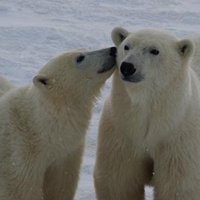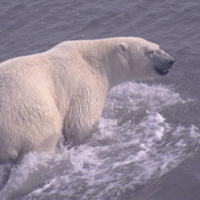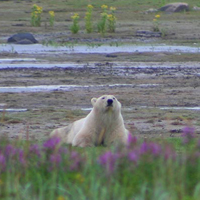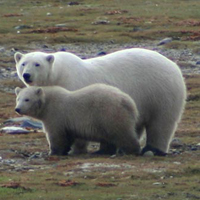Polar Bear
Scientific name: Ursus maritimus




Photo credits: Martyn Obbard, Ministry of Natural Resources and Forestry (left), Ken Abraham (middle-left) and Far North Branch (middle-right and right)
Status
Threatened
“Threatened ” means the species lives in the wild in Ontario, is not endangered, but is likely to become endangered if steps are not taken to address factors threatening it.
Date added to the Species at Risk in Ontario List
September 10, 2009
Read the most recent assessment report (PDF).
What it looks like
The Polar Bear is the largest species of bear and is among the largest carnivores found on land. The largest live captured bear from Ontario was a male weighing 654 kg (1,440 lbs). Females are lighter and smaller, usually weighing less than 300 kg (660 lbs).
The Polar Bear has translucent hair that appears white, allowing it to blend in with its snowy surroundings. It has water-repellent fur and large forepaws that make efficient paddles, making the Polar Bear a strong swimmer.
Where it’s been found in Ontario
The Ontario population of Polar Bears can be found on the sea ice of Hudson Bay and James Bay from late fall until early summer. During the winter, Polar Bears roam widely over the sea ice and hunt Ringed and Bearded Seals. When ice in Hudson Bay and James Bay melts, the bears are forced onto land for several months. During this time, they are dependent on fat reserves they stored over the winter. During fall, pregnant females dig maternity dens in the sides of palsas (raised peat mounds), gravel ridges and river banks.
What threatens it
Climate change is responsible for higher air temperatures in the north, causing the spring ice break-up to occur earlier and freeze-up to occur later. The extended ice-free season has a direct impact on the Polar Bear’s ability to hunt.
Action we are taking
This species and its habitat are protected under Ontario’s Endangered Species Act, 2007 (ESA).
The ESA also requires us to prepare recovery guidance for threatened species such as Polar Bear to guide recovery efforts for the species in Ontario.
All species listed on the Species at Risk in Ontario List may be eligible for consideration for government funding through the Species at Risk Stewardship Program.
Recovery strategy
A recovery strategy advises the ministry on ways to ensure healthy numbers of the species return to Ontario.
Read the executive summary and full document (December 7, 2011).
Government response statement
A government response statement outlines the actions the government intends to take or support to help recover the species.
Read the government response statement (December 16, 2016)
Review of progress
A review of progress made toward protecting and recovering a species is required no later than the time specified in the species’ government response statement, or not later than five years after the government response statement is published if no time is specified.
Read the report on progress towards the protection and recovery of 18 species at risk, including Polar Bear (2021).
What you can do
Report a sighting
Submit your observations of species at risk to the Natural Heritage Information Centre (NHIC), which is Ontario’s conservation data centre. Join the Centre’s “Rare Species of Ontario ” project in iNaturalist, an online plant and animal identification app, to make submitting your observations quick and easy.
Volunteer
Volunteer with your local nature club or provincial park to participate in surveys or stewardship work focused on species at risk.
Be a good steward
- Private landowners have a very important role to play in species recovery. If you find species at risk on your land, you may be eligible for stewardship programs that support the protection and recovery of species at risk and their habitats, such as the Species at Risk Stewardship Program.
- Reduce the impact of climate change by switching to compact fluorescent bulbs, adjusting your thermostat, taking shorter showers, and participating in tree planting initiatives.
Report illegal activity
Report any illegal activity related to plants and wildlife to
Quick facts
- Canada is home to two-thirds of the world’s Polar Bears.
- On average, a Polar Bear needs to eat the equivalent of 43 ringed seals to meet its yearly energy requirements.
- Pregnant female Polar Bears may not eat for up to eight months and may lose as much as 40% of their body mass during this time.
- Female Polar Bears give birth to one or two cubs, rarely three, each weighing a little over half a kilogram. Cubs are nursed inside the den for two to three months until they weigh about 10 to 12 kilograms. At that time, the mother leads her family back to the sea ice so she can resume hunting.
- The annual distance traveled by radio-collared Polar Bears can exceed 3,500 kilometres.